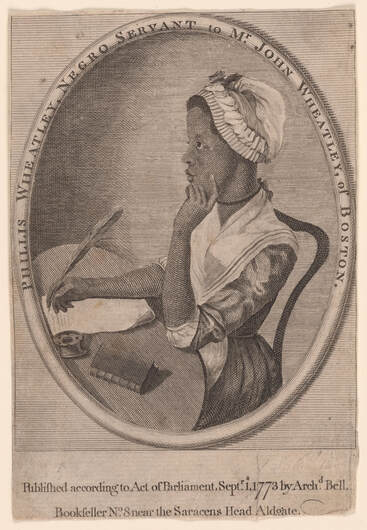 "Phillis Wheatley," 1773, National Portrait Gallery
"Phillis Wheatley," 1773, National Portrait Gallery
Phillis Wheatley (1753-1784) was taken from her birthplace in Africa and enslaved in the American colonies as a child. By the time she was a teenager, Wheatley had studied an array of different subjects, including literature, Latin, and Greek, and had begun to write her own poetry. She continued to pursue this interest and hone her talent, eventually publishing a collection of her works entitled Poems on Various Subjects, Religious and Mortal. With this publication, Phillis Wheatley became the first African-American poet to publish a book. However, because of Wheatley’s position as a black woman in colonial Boston, many people refused to believe that she could write such poetry. Wheatley’s books included a preface in which a bunch of well-known men (like John Hancock) signed their names to give their testimony that she had indeed written the poems inside. A portrait of Wheatley was included inside the front cover, adding further proof of the author’s identity.
Wheatley’s connection to King’s Chapel can be traced through this portrait. It is attributed to a man named Scipio Sarahson, also known as Scipio Morehead, a black artist enslaved by Presbyterian minister John Morehead. Clearly, their shared interests in the arts allowed Wheatley and Morehead to forge a connection and honor one another through their works; Morehead painted the author and Wheatley wrote a poem about the painter: “To S.M., A Young African Painter, On Seeing His Works”. Although neither Phillis Wheatley nor Scipio Morehead was a member of King’s Chapel, Scipio Morehead appears in the written records, having been baptised at the church on June 11, 1760. It is also possible that Wheatley would have attended services in the stone chapel during the American Revolution, when her congregation of Old South Meeting House was using King's Chapel's physical building.
Wheatley’s connection to King’s Chapel can be traced through this portrait. It is attributed to a man named Scipio Sarahson, also known as Scipio Morehead, a black artist enslaved by Presbyterian minister John Morehead. Clearly, their shared interests in the arts allowed Wheatley and Morehead to forge a connection and honor one another through their works; Morehead painted the author and Wheatley wrote a poem about the painter: “To S.M., A Young African Painter, On Seeing His Works”. Although neither Phillis Wheatley nor Scipio Morehead was a member of King’s Chapel, Scipio Morehead appears in the written records, having been baptised at the church on June 11, 1760. It is also possible that Wheatley would have attended services in the stone chapel during the American Revolution, when her congregation of Old South Meeting House was using King's Chapel's physical building.
Read Phillis Wheatley’s poem about Scipio Morehead and experience a bit of both artists’ talent: "To S. M., a Young African Painter, on Seeing His Works"
|
